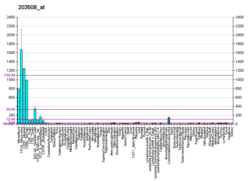Tumor necrosis factor receptor 2
Tumor necrosis factor receptor 2 (TNFR2), also known as tumor necrosis factor receptor superfamily member 1B (TNFRSF1B) and CD120b, is a membrane receptor that binds tumor necrosis factor-alpha (TNFα).[5][6]
Function
The protein encoded by this gene is a member of the tumor necrosis factor receptor superfamily, which also contains TNFRSF1A. This protein and TNF-receptor 1 form a heterocomplex that mediates the recruitment of two anti-apoptotic proteins, c-IAP1 and c-IAP2, which possess E3 ubiquitin ligase activity. The function of IAPs in TNF-receptor signalling is unknown, however, c-IAP1 is thought to potentiate TNF-induced apoptosis by the ubiquitination and degradation of TNF-receptor-associated factor 2 (TRAF2), which mediates anti-apoptotic signals. Knockout studies in mice also suggest a role of this protein in protecting neurons from apoptosis by stimulating antioxidative pathways.[7]
Interactions
TNFRSF1B has been shown to interact with:
References
- 1 2 3 GRCh38: Ensembl release 89: ENSG00000028137 - Ensembl, May 2017
- 1 2 3 GRCm38: Ensembl release 89: ENSMUSG00000028599 - Ensembl, May 2017
- ↑ "Human PubMed Reference:".
- ↑ "Mouse PubMed Reference:".
- ↑ Schall TJ, Lewis M, Koller KJ, Lee A, Rice GC, Wong GH, Gatanaga T, Granger GA, Lentz R, Raab H, et al. (June 1990). "Molecular cloning and expression of a receptor for human tumor necrosis factor". Cell. 61 (2): 361–70. doi:10.1016/0092-8674(90)90816-W. PMID 2158863.
- ↑ Santee SM, Owen-Schaub LB (October 1996). "Human tumor necrosis factor receptor p75/80 (CD120b) gene structure and promoter characterization". J Biol Chem. 271 (35): 21151–9. doi:10.1074/jbc.271.35.21151. PMID 8702885.
- ↑ "Entrez Gene: TNFRSF1B tumor necrosis factor receptor superfamily, member 1B". Retrieved 8 May 2017.
- ↑ Bouwmeester T, Bauch A, Ruffner H, Angrand PO, Bergamini G, Croughton K, Cruciat C, Eberhard D, Gagneur J, Ghidelli S, Hopf C, Huhse B, Mangano R, Michon AM, Schirle M, Schlegl J, Schwab M, Stein MA, Bauer A, Casari G, Drewes G, Gavin AC, Jackson DB, Joberty G, Neubauer G, Rick J, Kuster B, Superti-Furga G (2004). "A physical and functional map of the human TNF-alpha/NF-kappa B signal transduction pathway". Nat. Cell Biol. 6 (2): 97–105. doi:10.1038/ncb1086. PMID 14743216.
- ↑ Song HY, Donner DB (1995). "Association of a RING finger protein with the cytoplasmic domain of the human type-2 tumour necrosis factor receptor". Biochem. J. 309 (3): 825–9. PMC 1135706. PMID 7639698.
- ↑ Takeuchi M, Rothe M, Goeddel DV (1996). "Anatomy of TRAF2. Distinct domains for nuclear factor-kappaB activation and association with tumor necrosis factor signaling proteins". J. Biol. Chem. 271 (33): 19935–42. doi:10.1074/jbc.271.33.19935. PMID 8702708.
- ↑ Hostager BS, Bishop GA (2002). "Role of TNF receptor-associated factor 2 in the activation of IgM secretion by CD40 and CD120b". J. Immunol. 168 (7): 3318–22. doi:10.4049/jimmunol.168.7.3318. PMID 11907088.
- ↑ Rothe M, Xiong J, Shu HB, Williamson K, Goddard A, Goeddel DV (1996). "I-TRAF is a novel TRAF-interacting protein that regulates TRAF-mediated signal transduction". Proc. Natl. Acad. Sci. U.S.A. 93 (16): 8241–6. doi:10.1073/pnas.93.16.8241. PMC 38654. PMID 8710854.
- ↑ Marsters SA, Ayres TM, Skubatch M, Gray CL, Rothe M, Ashkenazi A (1997). "Herpesvirus entry mediator, a member of the tumor necrosis factor receptor (TNFR) family, interacts with members of the TNFR-associated factor family and activates the transcription factors NF-kappaB and AP-1". J. Biol. Chem. 272 (22): 14029–32. doi:10.1074/jbc.272.22.14029. PMID 9162022.
- ↑ Carpentier I, Coornaert B, Beyaert R (2008). "Smurf2 is a TRAF2 binding protein that triggers TNF-R2 ubiquitination and TNF-R2-induced JNK activation". Biochem. Biophys. Res. Commun. 374 (4): 752–7. doi:10.1016/j.bbrc.2008.07.103. PMID 18671942.
- ↑ Pype S, Declercq W, Ibrahimi A, Michiels C, Van Rietschoten JG, Dewulf N, de Boer M, Vandenabeele P, Huylebroeck D, Remacle JE (2000). "TTRAP, a novel protein that associates with CD40, tumor necrosis factor (TNF) receptor-75 and TNF receptor-associated factors (TRAFs), and that inhibits nuclear factor-kappa B activation". J. Biol. Chem. 275 (24): 18586–93. doi:10.1074/jbc.M000531200. PMID 10764746.
Further reading
- Kollias G, Kontoyiannis D (2003). "Role of TNF/TNFR in autoimmunity: specific TNF receptor blockade may be advantageous to anti-TNF treatments". Cytokine Growth Factor Rev. 13 (4–5): 315–21. doi:10.1016/S1359-6101(02)00019-9. PMID 12220546.
- Holtmann MH, Schuchmann M, Zeller G, et al. (2003). "The emerging distinct role of TNF-receptor 2 (p80) signaling in chronic inflammatory disorders". Arch. Immunol. Ther. Exp. (Warsz.). 50 (4): 279–88. PMID 12371624.
- Horiuchi T, Kiyohara C, Tsukamoto H, et al. (2007). "A functional M196R polymorphism of tumour necrosis factor receptor type 2 is associated with systemic lupus erythematosus: a case-control study and a meta-analysis". Ann. Rheum. Dis. 66 (3): 320–4. doi:10.1136/ard.2006.058917. PMC 1856025. PMID 17028114.
External links
- CD120b+Antigen at the US National Library of Medicine Medical Subject Headings (MeSH)




